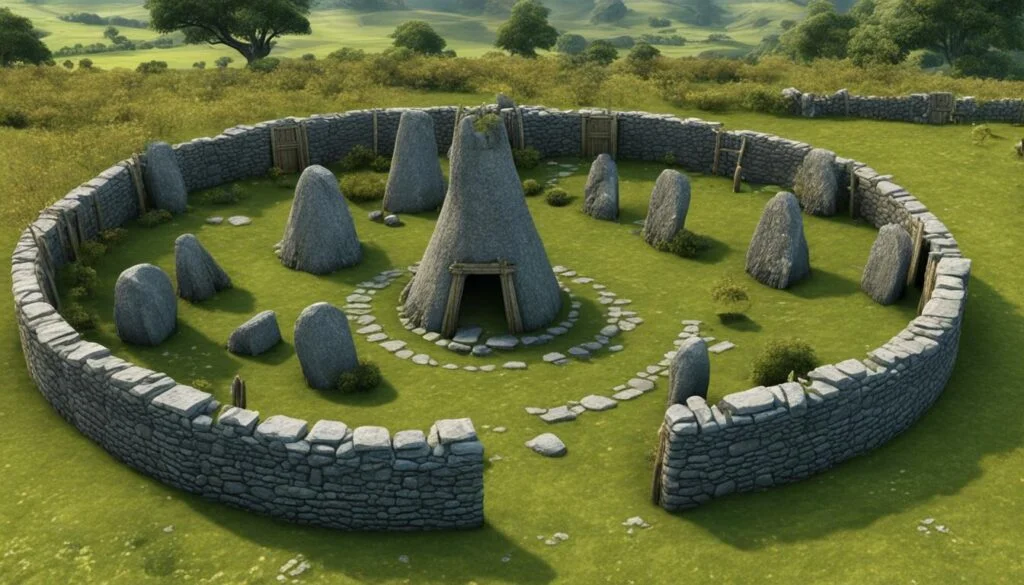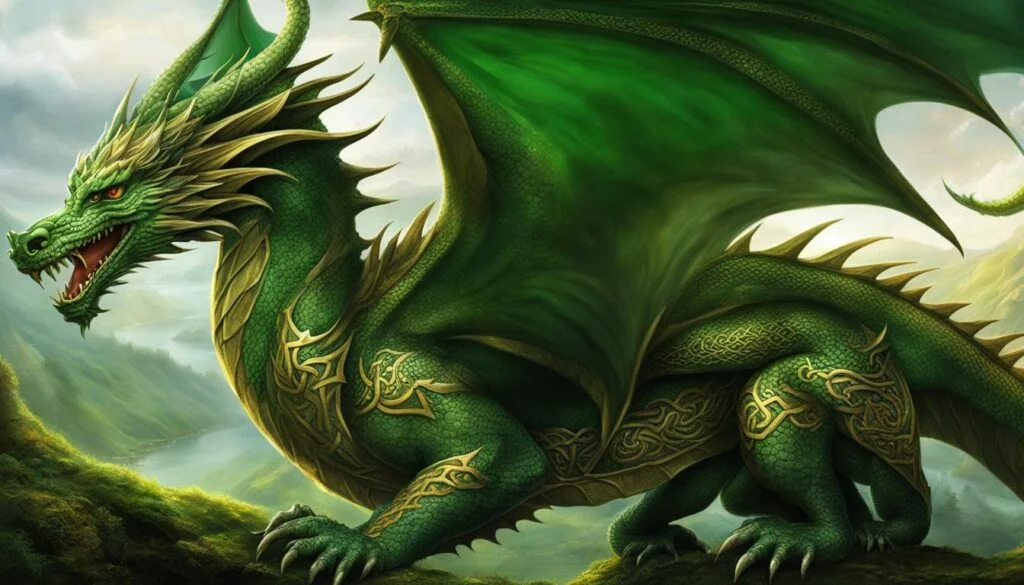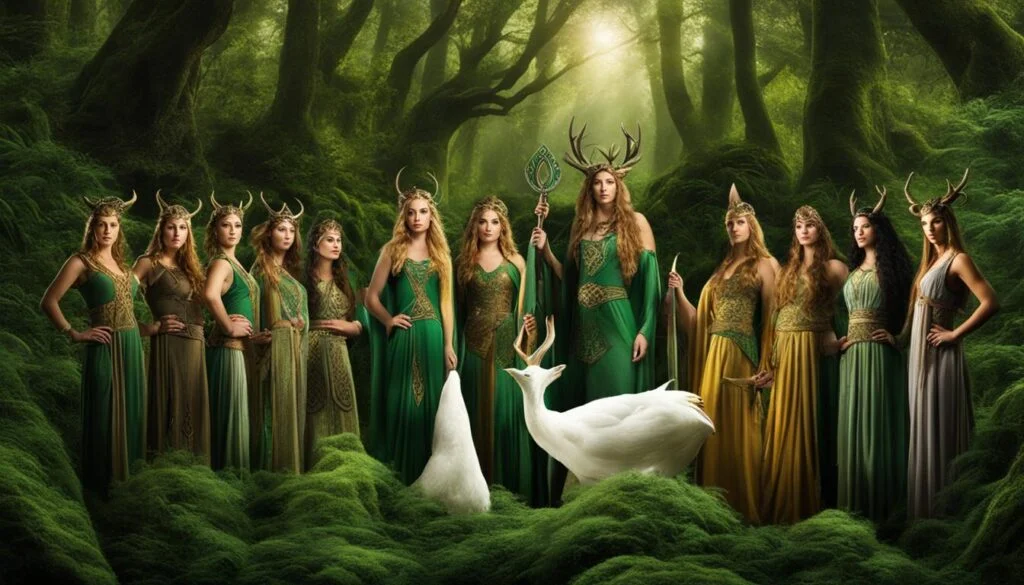Who were the Druids? What were their roles in ancient Celtic societies? Explore the fascinating world of the Druids and uncover the mysteries of their ancient Celtic culture and religious practices. In this article, we will delve into the intricate roles of the Druids, their rituals, and their influence on Celtic mystical traditions.
Key Takeaways:
- The Druids served as priests, teachers, and judges in ancient Celtic societies.
- They were highly respected and held significant influence in Celtic culture.
- Druids conducted public and private sacrifices and instructed young men.
- They acted as mediators in disputes and held annual assemblies to settle legal matters.
- Druids were deeply connected to nature and had a reverence for trees, particularly the oak.
The Origins and Meaning of Druids
Druids, a key element of ancient Celtic societies, have origins rooted in nature and a deep connection to the mystical traditions of the Celts. The word “druid” is believed to come from a Celtic term that means “knower of the oak tree,” signifying the importance of trees in their practices. Among the various trees, druids held a particular reverence for the oak.
As part of a shamanic religion, druids engaged in spiritual practices that involved contact with the spirit world. They possessed knowledge of holistic medicine and were capable of both healing and causing illness. The exact origin and meaning of the word “druid” remain uncertain, but it is widely associated with wisdom and knowledge, emphasizing the central role played by druids in the ancient Celtic culture.
Druids may have drawn inspiration from megalithic traditions, which encompassed ancient rituals and religious practices. The connection between the druids and their predecessor’s traditions demonstrates a continuous link in the mystical and spiritual aspects of Celtic culture throughout the ages.
- Druids, deeply connected to nature
- Mystical traditions and rituals
- Reverence for trees, especially the oak
- Shamanic practices and contact with the spirit world
The Roles and Responsibilities of Druids
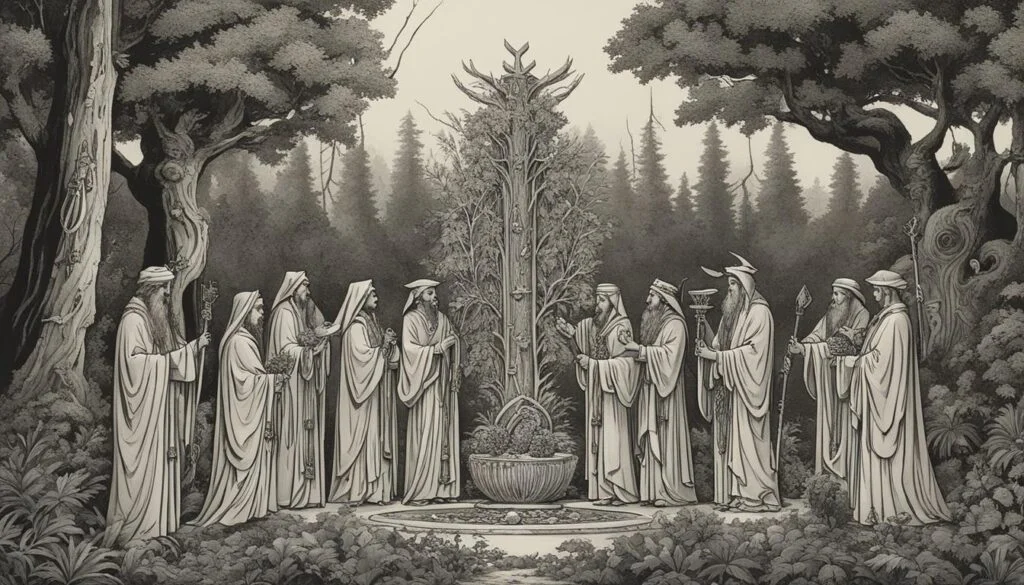
In ancient Celtic societies, druids played diverse and essential roles, serving not only as religious leaders but also as legal authorities, adjudicators, lorekeepers, medical professionals, and political advisors. The druids acted as intermediaries between the people and the gods, fulfilling various duties and responsibilities.
One of the primary responsibilities of druids was to organize and conduct religious rituals and worship. They performed sacrifices and other religious ceremonies, honoring the Celtic gods and maintaining the spiritual well-being of the community. The druids’ intricate knowledge of ritual practices and their ability to connect with the mystical aspects of nature made them pivotal figures in the ancient Celtic religious landscape.
Druids also served as legal authorities, responsible for resolving disputes and maintaining justice within the community. They acted as judges in public and private cases, ensuring fair and impartial decisions. Druids possessed an in-depth understanding of both customary and divine law, applying their wisdom to settle legal matters and maintain social order.
As lorekeepers, druids were the custodians of ancient Celtic knowledge and traditions. They were entrusted with preserving and transmitting oral literature, including myths, legends, and historical accounts. This role ensured the preservation of the rich cultural heritage of the Celtic people, passing down stories and teachings from one generation to the next.
Moreover, druids held expertise in medicine and healing practices, employing their understanding of botanical remedies and holistic medicine. They provided medical care and guidance to the community, employing both physical and spiritual means to treat ailments and illnesses. The druids’ holistic approach to healthcare highlighted their belief in the interconnectedness of the body, mind, and spirit.
Druids also played a significant role as political advisors in Celtic societies. They provided counsel to tribal leaders and rulers, offering strategic guidance and insights on various matters. Their spiritual wisdom and ability to interpret omens and signs made them valuable advisors in decision-making processes.
Furthermore, druids possessed social influence and authority that extended beyond their religious and legal roles. They had the power to excommunicate individuals from religious festivals, effectively ostracizing them from the community. This social penalty carried significant repercussions, reinforcing the druids’ influence and the importance of maintaining religious harmony.
Druids enjoyed high levels of respect and were exempt from military service and taxes, highlighting their prominent status within Celtic societies. In times of conflict, druids possessed the extraordinary ability to prevent warfare by intervening between two opposing armies. Their role as peacemakers exemplified their power to negotiate, mediate, and forge diplomatic resolutions.
The roles and responsibilities of druids encapsulated their multi-faceted contributions to the ancient Celtic culture. Their roles as religious leaders, legal authorities, lorekeepers, medical professionals, and political advisors showcased their indispensable place in Celtic societies and their profound influence on the development of Celtic mystical traditions.
Druidic Beliefs and Practices

Druidism was deeply rooted in celtic religious practices, encompassing a rich tapestry of rituals and ceremonies. The druids believed in the immortality of the soul, and that after death, souls entered into another body, a concept known as metempsychosis. They revered the cycles of the moon, the sun, and the changing seasons, shaping their spiritual practices around these celestial phenomena.
Druidic rituals and worship took place in secluded areas, such as clearings in the woods or stone circles. These natural settings provided a connection to the spiritual realm and allowed the druids to commune with the gods and spirits of nature.
The oral traditions of the druids, their extensive knowledge and verse, were a cornerstone of their mystical traditions. It took many years of dedicated study and practice to master the vast repertoire of knowledge held by the druids.
Druids possessed a deep understanding of nature, astronomy, and the lore of the gods. They were the keepers of ancient wisdom, revered for their ability to interpret the signs and symbols that permeated the natural world.
The Eight Holy Days
The druids celebrated eight main holy days throughout the year, marking significant transitions in the natural world and the spiritual realm. These festivals, closely aligned with the changing seasons and agricultural cycles, were occasions for communal gatherings and sacred rituals.
- Samhain (pronounced SOW-in) – Celebrated on November 1st, it marked the end of the harvest season and the beginning of winter. It was a time to honor ancestors and commune with spirits.
- Yule – Celebrated around the winter solstice, it marked the rebirth of the sun and the return of longer days. It symbolized the victory of light over darkness.
- Imbolc (pronounced IM-bulk) – Celebrated on February 2nd, it marked the beginning of spring and the returning fertility of the earth. It was dedicated to the goddess Brigid.
- Ostara – Celebrated around the spring equinox, it honored the balance between light and dark and the awakening of nature. It symbolized new beginnings and growth.
- Beltane – Celebrated on May 1st, it marked the beginning of summer and the peak of fertility. It was a time of joy, celebration, and the weaving of Maypoles.
- Midsummer – Celebrated around the summer solstice, it celebrated the peak of the sun’s power and the abundance of nature. It was a time for bonfires and divination.
- Lughnasadh (pronounced LOO-nuh-suh) – Celebrated on August 1st, it marked the beginning of the harvest season. It was a time to show gratitude for the bounty of the land.
- Mabon – Celebrated around the autumn equinox, it marked the second harvest and the beginning of autumn. It symbolized the balance between light and dark and the appreciation of abundance.
The celebration of these holy days allowed the druids to connect with the changing energies of nature, fostering a deep spiritual connection with the natural world and the divine forces that guided it.
Druidic Influence and Decline
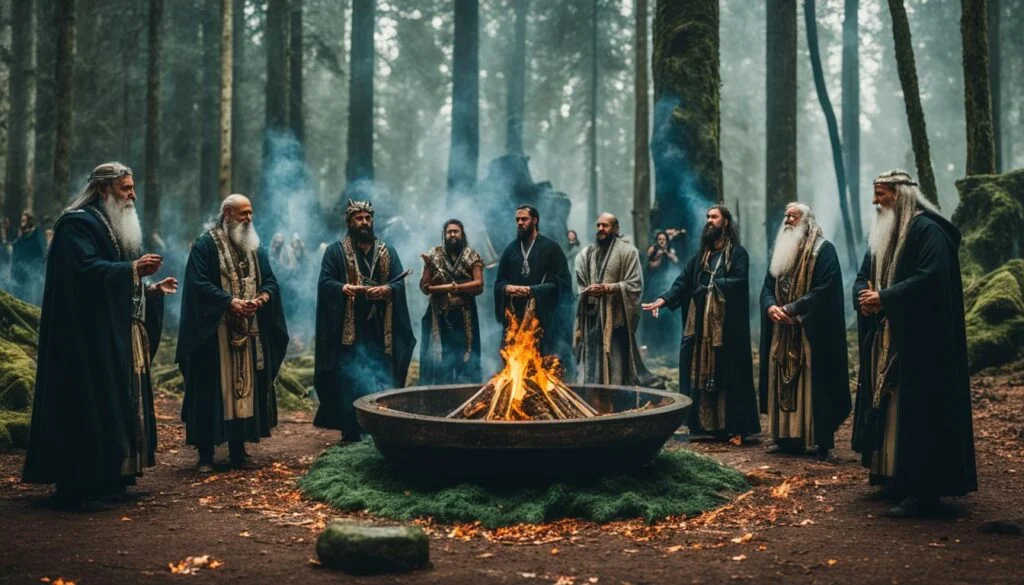
Druids played a significant role in ancient Celtic societies, holding influential positions as spiritual leaders and acting as a bridge between the people and the gods. Their deep connection with nature and their ability to connect with the spiritual realm earned them great respect.
The Druids possessed the authority to banish individuals from society if they broke sacred laws. This power allowed them to maintain order and uphold the moral fabric of the community. However, the rise of the Roman Empire saw the suppression of Druidism in Gaul and Britain, leading to the decline of their roles.
By the 2nd century, Druidism had largely disappeared from written records, and their practices and beliefs started to fade from memory. Factors such as the influence of Christianity and the Roman Empire’s dominance may have contributed to the decline of Druidism in ancient Celtic societies.
Controversies and Misconceptions

The Roman writers who recorded information about the Druids may have exaggerated or distorted some aspects of their rituals and practices. While there are mentions of human sacrifice, there is limited definitive evidence to support this claim. Some scholars believe that accusations of human sacrifice were Roman propaganda designed to portray the Druids as barbaric. Additionally, the lack of written records by the Druids themselves contributes to the mystery and misconceptions surrounding their practices.
Despite the ambiguous nature of the available historical accounts, the fascination with the Druids and their ancient Celtic religious practices persists. The depictions of human sacrifice and the mysterious rituals associated with the Druids may have captured the imagination of later generations, reinforcing misconceptions about their true beliefs and practices.
As we delve deeper into the world of ancient Celtic societies and the role of the Druids, it is important to approach the topic with an open mind. While our knowledge may be limited, exploring the remaining fragments of evidence can uncover valuable insights into the religious and spiritual practices of this ancient civilization.
Druidic Sites and Legacy
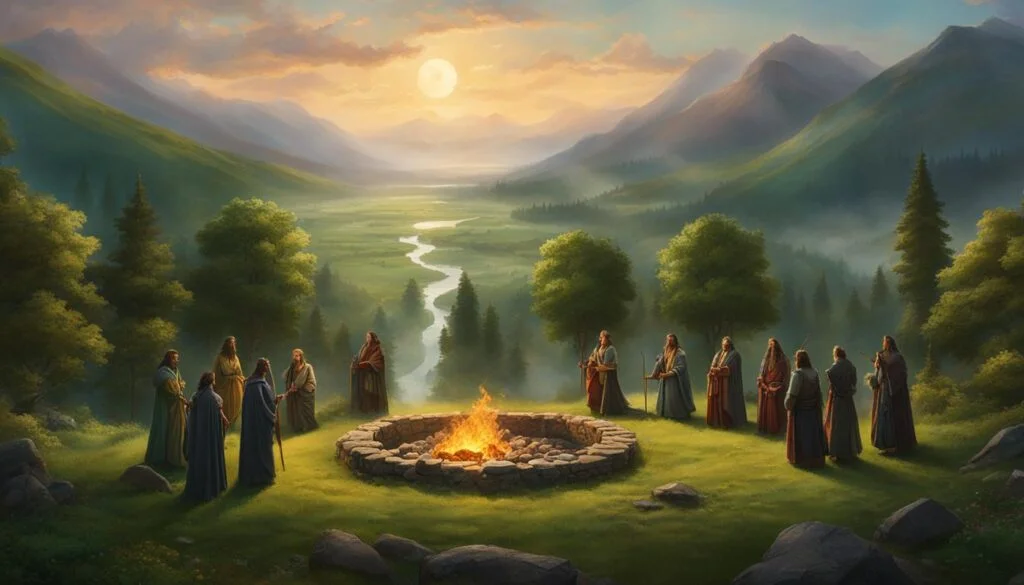
Druids, the revered figures of ancient Celtic societies, are often associated with mystical stone circles shrouded in mystery. One such iconic site is Stonehenge, believed to have served as a place of worship for the Druids. The massive stones and intricate arrangements have captivated generations, leaving behind a tangible connection to ancient Celtic traditions and druid rituals.
But Stonehenge is not the only location associated with the Druids. The Isle of Ynys Mon in Anglesey and Wistman’s Wood in Dartmoor are also potential sites where Druidic practices may have taken place. These mystical locations offer a glimpse into the spiritual and cultural significance druid rituals held in ancient times.
Druidism, with its deep connection to nature and spiritual practices, has left a lasting legacy in modern religions. Christianity and Wicca, among others, have drawn inspiration from ancient druidic beliefs and integrated elements of Celtic mystical traditions into their own practices.
Moreover, the fascination with the druids and their mystical traditions continues to influence contemporary cultures. The revival of interest in the druids in the 18th and 19th centuries sparked the Neo-Druidism movement, seeking to reclaim and reinterpret the ancient druid rituals and teachings.
The rich history of the druids and their enigmatic legacy evoke a sense of wonder and curiosity, reminding us of the enduring power of ancient Celtic societies and the mystical traditions they held dear.
Modern Interpretations and Revivals
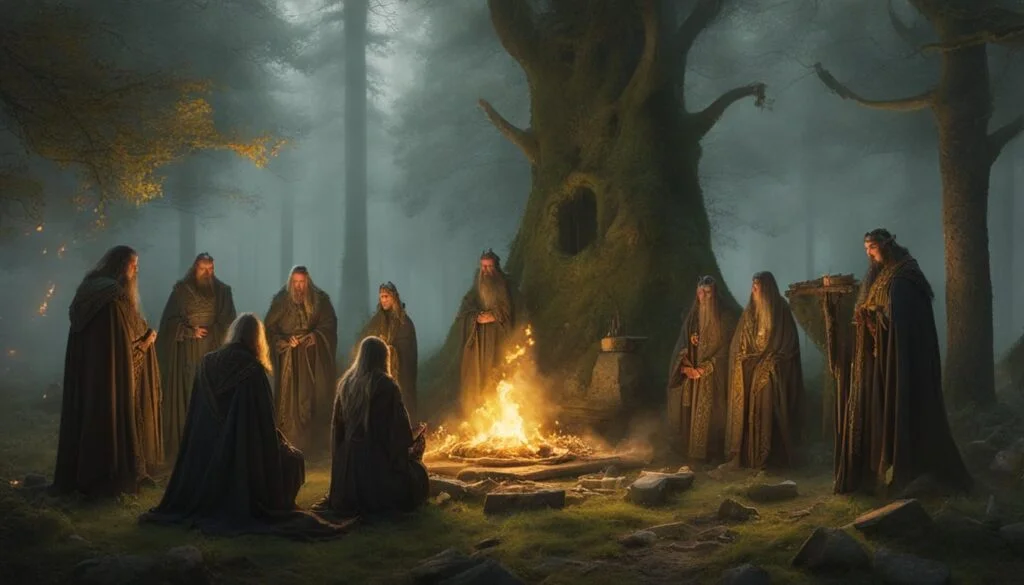
In the 18th and 19th centuries, a renewed interest in the Druids sparked the establishment of fraternal and neopagan groups dedicated to reviving and reviving the ancient Druidic beliefs. Known as Neo-Druidism, these movements aimed to reinterpret the practices and rituals of the ancient Druids in a modern context.
Neo-Druidism sought to connect with the ancient Celtic culture that the Druids were an integral part of. Drawing inspiration from ancient texts and archaeological findings, these groups sought to reconstruct and adapt the religious practices and spiritual beliefs of the ancient Druids to suit contemporary sensibilities.
One such belief system that has incorporated elements of Druidic traditions is Wicca. Wicca, a modern pagan religion, looks to the ancient Celts and their religious practices as a source of inspiration. Wiccans often honor and celebrate nature, drawing parallels to the reverence for the natural world that was central to ancient Druidic beliefs.
The legacy of the Druids continues to fascinate and inspire many people today. The revival of interest in these ancient priests and their mystical traditions has brought a deeper understanding of ancient Celtic culture and its religious practices.
Through these modern interpretations and revivals, a connection with the past is established, allowing individuals to explore and embrace the wisdom and spirituality of the ancient Celtic priests, the Druids.
Conclusion
Ancient Celtic societies were deeply shaped by the influential and respected role of the Druids. These knowledgeable priests, teachers, judges, and advisors played a vital part in the cultural and religious practices of their time, acting as mediators between the people and the gods.
Despite the mysteries that surround their knowledge and practices, the legacy of the Druids continues to captivate and inspire people today. Their mystical traditions and close connection with nature have left an indelible mark on the ancient Celtic culture and have even influenced the development of related spiritual movements.
As we delve into the ancient Celtic societies, we gain a glimpse into a mesmerizing world filled with the rituals, beliefs, and wisdom of the Druids. Although much remains unknown, their significant roles and profound impact on Celtic culture are undeniable, reminding us of their enduring influence on the ancient Celtic priests and the mystical traditions they upheld.
FAQ
Who were the Druids and what roles did they play in ancient Celtic societies?
The Druids were a learned class among the ancient Celts, serving as priests, teachers, and judges. They played pivotal roles in Celtic societies, responsible for public and private sacrifices, instructing young men, and acting as judges in both public and private disputes. They held annual assemblies to settle legal matters and were considered influential and powerful figures in Celtic culture.
What is the origin and meaning of the word “Druid”?
The word “druid” may come from a Celtic word meaning “knower of the oak tree.” Druids were deeply connected to nature and held a reverence for trees, particularly the oak. They were part of a shamanic religion, using contact with the spirit world and holistic medicine to treat and sometimes cause illness. Their knowledge and practices may have been influenced by megalithic traditions.
What were the multifaceted roles of the Druids in Celtic societies?
Druids were not only religious leaders but also legal authorities, adjudicators, lorekeepers, medical professionals, and political advisors. They were responsible for organizing worship, sacrifices, divination, and judicial procedures. They held the power to excommunicate individuals from religious festivals, making them social outcasts. Druids were highly respected and exempt from military service and taxes, and they could even prevent warfare by intervening between two opposing armies.
What were the religious beliefs and practices of the Druids?
Druids were polytheistic and believed in the immortality of the soul and metempsychosis, the idea that souls enter into another body after death. They followed lunar, solar, and seasonal cycles and celebrated eight main holy days throughout the year. Druidic rituals and worship took place in secluded areas, such as clearings in woods and stone circles. While druids’ oral literature has not survived, they were known for their extensive knowledge and verse, which took many years to master. They likely possessed a deep understanding of nature, astronomy, and the lore of the gods.
What led to the decline of the Druids and their influence in Celtic societies?
The Roman government suppressed the Druids in Gaul and Britain, resulting in their roles and influence gradually declining. By the 2nd century, Druidism had disappeared from written records, and their practices and beliefs were largely forgotten. The influence of Christianity and the rise of the Roman Empire may have contributed to the decline of Druidism.
Are there any controversies and misconceptions surrounding the Druids?
The Roman writers who recorded information about the Druids may have exaggerated or distorted some aspects of their rituals and practices. There are mentions of human sacrifice, but limited definitive evidence supports this claim. Some scholars believe that accusations of human sacrifice were Roman propaganda designed to portray the Druids as barbaric. Additionally, the lack of written records by the Druids themselves contributes to the mystery and misconceptions surrounding their practices.
Are there any notable Druidic sites and what is the legacy of the Druids?
Druids are often associated with stone circles, such as Stonehenge, which is believed to have been a place of worship for the Druids. Other potential Druidic sites include the Isle of Ynys Mon in Anglesey and Wistman’s Wood in Dartmoor. Druidism has left a legacy in modern religions, such as Christianity and Wicca, as well as in the cultural fascination with mystical and spiritual traditions. The revival of interest in the Druids occurred in the 18th and 19th centuries, sparking the Neo-Druidism movement.
Are there any modern interpretations and revivals of the ancient Druidic beliefs?
In the 18th and 19th centuries, there was a renewed interest in the Druids, leading to the establishment of fraternal and neopagan groups based on the ancient Druidic beliefs. These movements, known as Neo-Druidism, aimed to revive and reinterpret the practices and rituals of the ancient Druids. Some modern religions, such as Wicca, have incorporated elements of Druidic traditions into their practices. The legacy of the Druids continues to fascinate and inspire many people today.


